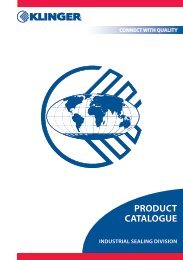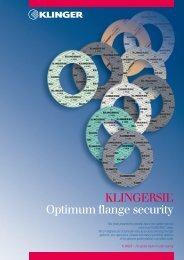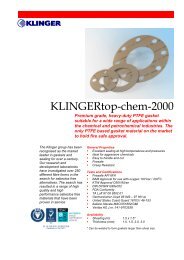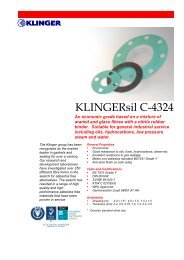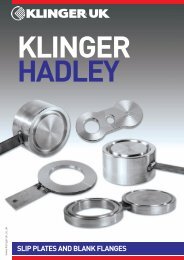to Download PDF 3.44MB - KLINGER Australia
to Download PDF 3.44MB - KLINGER Australia
to Download PDF 3.44MB - KLINGER Australia
You also want an ePaper? Increase the reach of your titles
YUMPU automatically turns print PDFs into web optimized ePapers that Google loves.
The requirements on thegasket materialThe types of stress described above meanthat special demands are placed on thegasket material. They include:n Low shrinkage, even under temperaturestress, in order <strong>to</strong> maintain thesealing forces.n Edge stability, despite unfavorable ringwidth (thickness/width ratio)n Resistance <strong>to</strong> shear or frictionalforces arising from possible relativemotion of the gasket surfaces duringassembly.Additionally:n The gasket material must be able<strong>to</strong> conform <strong>to</strong> the seal counterpart(metal surfaces are standard) sothat no leaks occur on the contactsurfaces.n The sealing material must also beimpermeable, so that this leakageroute is also eliminated.The sealing sequenceIn the case of standard ring gaskets madefrom soft fibrous materials (filler, fibers,elas<strong>to</strong>mer as the binder), the sealing processensues as follows:The gasket is pressed:n It adapts <strong>to</strong> the surfaces of the sealingcounterpart and seals the contactsurfaces.n In so doing, the cross section of thegasket is placed under mechancalpressure and the existing capillariesand cavities are closed.n This process requires a certain time,however, and is associated with a lossof thickness in the gasket.On first heating, the gasket materialagain becomes slightly softerand resets - with additional loss ofthickness.If, therefore, higher demands are <strong>to</strong> beplaced on the security of the threadedunion, also from a temperature andduration point of view, standard materialsare no longer able <strong>to</strong> satisfy thesedemands.The alternativesWhich gaskets can be seen as alternatives,and how are they <strong>to</strong> be assessed?n Rubber gasket rings - these are veryimpermeable and have an excellentability <strong>to</strong> adapt; nevertheless, theypossess low stability when faced withhigher demands relating <strong>to</strong> temperatureand screw forces.n Metal gasket rings - these arevery stable and impermeable, butadapt insufficiently <strong>to</strong> the sealingsurfaces.n Pure graphite gasket rings - thesehave very high adaptability, but are<strong>to</strong>o fragile during assembly and copebadly with the unfavorable thickness/width ratios.n PTFE gasket rings - these exhibit highconformability and are impermeablebut standard materials still possessexcessive flow properties.5Rich. <strong>KLINGER</strong> Ind e Com Ltda., Brazil<strong>KLINGER</strong> GmbH lectures at the 15 thInternational Sealing Conference<strong>KLINGER</strong> GmbH <strong>to</strong>ok advantage of the 15 th ISC in Oc<strong>to</strong>ber 2008 in Stuttgart<strong>to</strong> showcase their PTFE gasket materials and <strong>to</strong> lecture on the stabilityof PTFE-material for narrow gaskets. Sales Manager Norbert Weimer, KLIN-GER GmbH, presented the latest results of research and development andthe experiences of applications in practice for <strong>KLINGER</strong><strong>to</strong>p-chem-2000.The prospects for PTFE gaskets aretherefore exrtremely good if the problemsassociated with flow characteristics canbe solved.The following features and measurementswill allow an evaluation of the flowcharacteristics:n Compressibilityn Residual surface pressure on thegasket after temperature cycling





